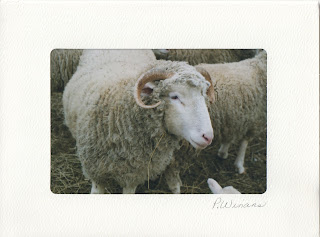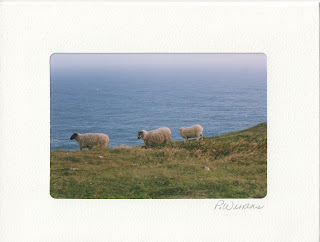| A labyrinth we enjoyed along the Camino de Santiago trail |
The El Camino de Santiago route is designated as a UNESCO World Heritage Site and once I Iearned about it, I was intrigued to experience it for myself. A few friends had completed the journey and I wanted to learn the history of the route and to experience and enjoy the freedom of having nothing else to do all day except to walk and to take a personal retreat.
The path was very busy. With the exception of a few who were returning by the same path, we were all heading west. Some made their way on foot, others on horseback and others on bicycles. I also saw someone pushing another in a wheelchair. How far they were going I don't know, but taking into consideration the difficulty of the trail at times, one can hardly imagine the task. Persons of all nationalities walked together and we managed to communicate as best we could, despite our lack of a common language most of the time. Some traveled with friends, many were solo - everyone was willing to share what they had if someone needed their help.
The history of El Camino de Santiago begins over a thousand years ago. During medieval times it was one of the most important Christian pilgrimage routes leading to the Cathedral in Santiago where the remains of the apostle Saint James are buried. Some continue to walk the route as a pilgrimage, seeking atonement for sins or healing. Others tell of wanting the physical exercise, the sport of the hike or as I did, as a form of personal retreat.
Many of the walkers make their plans on a day to day basis, staying at night in one of the many communal hostels en route. My group chose a guided tour. We enjoyed the creature comforts of knowing that we had a comfortable bed at night and a bath (we often stayed in converted monasteries) and our meals were prepared along the way. We were roughly divided into three groups and three exceptional guides accompanied us to make sure we followed the right trail, saw the important sites and kept safe. I booked the trip through a hiking group in Toronto (Walker's World) but the fellow who led us will also put together a private package for individuals or smaller groups (gary@spanishadventures.com). He gives you a GPS and a telephone and although he is not with you physically, he checks on you carefully every day. We were never rushed. We started walking about 9 a.m. and after a tea break in a village along the way, walked on and met at a pre-arranged lunch stop at a little bar or had a picnic prepared for us by our guides. Dinner wasn't until 8 or 8:30 p.m. so we had lots of time to make our way to our final stop for the night.
Any route to the shrine of Santiago de Compostela in Spain is considered a pilgrim's path and the one that we followed began on the French border at Saint-Jean-Pied-de-Port. We didn't complete the entire route - sections that were the most historic and scenic were chosen by our guides for us and this included routes through the mountains, across the plains, through vineyards, wooded sections and farmer's fields. We didn't need to carry a large pack - the bulk of our belongings were transported for us to our evening destination.
I enjoyed walking on the plains - reminded me of the Canadian west with big blue skies and miles of corn and sunflower fields. Then there were the sheep - sometimes out alone in the fields but most often with their shepherd and their ever vigilant dogs. As we passed through the villages, the village dogs greeted us first - all sizes and breeds - and were so happy to see company coming. Local entrepreneurs met us with treats - like the lady with the crepes sprinkled with sugar for only 50 Spanish cents each!
I managed to gather a little bit of sheep wool that clung to a fence where the sheep found a hole big enough to scrunch through. This bit of fleece will become part of a hooked piece as soon as I can collect my thoughts and put it together.
To prepare for the trek I began walking 8 to 10 km. a day in very good and well-fitted hiking boots. My biggest challenge was the altitude of most of the trail. When we began, we were were in the Pyrenees and continued on through part of the Goose Mountains and then into another mountain range coming in to Santiago. I live at sea level so my trouble came from needing to adapt to the thin air at the highest altitudes. Despite reading about and being warned about the possibility of developing blisters on my feet from the many kilometers of walking, that was never an issue. If you do as suggested and wear two pairs of socks, use vaseline on your feet regularaly and use moleskin before you really need it, you can prevent problems.
| Spent a few days in Bilbao, Spain before the trek and enjoyed the Guggenheim Art Museum. The design of the building is amazing. |
 |
| Spider webs on the bridge in Saint-Jean-Pied-de-Port, France. Great designs! |
| On the trail near the Spanish/French border. Lots of sheep! |
| Wool left behind on the barbed fence as the sheep move around the mountain |
| Walking along in the Pyrenees |
 |
| Belling the horse! |
| Always lots of sheep! |
| Along the trail |
 | |
| Took a side trip into Pamploma to see the route of the Running of the Bulls |
| Wide open spaces and deserted 10th or 11th century buildings. The little black spec in the field is another pilgrim taking a photo. |
 |
| Modern day sculptures along the route |
| 13th century church still in use at Eunate |
 | |
| Taking a well deserved break! |
 |
| The Queen's Bridge - part of the pilgrim's path leading into the village |
 |
| Crossing one of the original Roman bridges that still make up part of the Camino |
 |
| All along the route, the scallop shell in the sidewalk, on markers, buildings and signs, shows you the way |
 |
| One of our group |
 |
| A popular children's toy that we saw children playing with in all the villages |
| Our fearless leader, Gary, keeping us on the right path! |
| My balcony view of the Cathedral in Burgos |
 |
| On the trail again |
| Nary a soul in the village streets at siesta time except us! |
 |
| High on the plain, everything was very dry - very little rain since May and the wind whipped the dust around us |
| A modern day shepherd and his dogs |
| Our worst day for weather was the section near the Iron Cross |
 |
| Checking the trail |
| Some rode on horseback.... |
 |
| and others hitched a ride on a bicycle! |
| High on the trail in beautiful Galicia |
| Following the livestock through a farmer's yard |
| Inside our destination, the Cathedral in Santiago. We attended the noon mass and were blessed by being present for the 'swinging of the botafumerio'; something that only happens on special occasions. |
| The official end of the pilgrimage - in the square in front of the Cathedral de Santiago de Compostela! |
Here is some wool and ribbons that I brought back from Spain for my next fibre project!
(All blog content copyrighted to Patricia Winans )
















